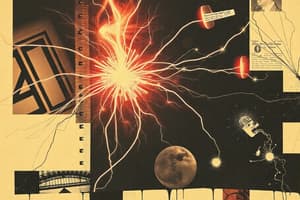Podcast
Questions and Answers
What is the result when an object has equal amounts of positive and negative charge?
What is the result when an object has equal amounts of positive and negative charge?
- The object loses its charge completely.
- The object becomes magnetically charged.
- The object is electrically neutral. (correct)
- The object becomes electrically charged.
What carries positive charges in an object?
What carries positive charges in an object?
- Neutrons
- Electrons
- Ions
- Protons (correct)
How is an object made positively charged?
How is an object made positively charged?
- By adding electrons to the object
- By increasing the number of protons in the object
- By removing electrons from the object (correct)
- By decreasing the number of neutrons in the object
What is the term for the process of charging an object through contact or friction?
What is the term for the process of charging an object through contact or friction?
What happens to the cloth when a plastic ruler is rubbed against it?
What happens to the cloth when a plastic ruler is rubbed against it?
What determines the tendency of materials to gain or lose electrons in tribo-electric charging?
What determines the tendency of materials to gain or lose electrons in tribo-electric charging?
What is the result of rubbing wool against amber?
What is the result of rubbing wool against amber?
What is the net charge of an object with eight positive charges and six negative charges?
What is the net charge of an object with eight positive charges and six negative charges?
What is the force exerted by static charges on each other called?
What is the force exerted by static charges on each other called?
What happens when like charges interact with each other?
What happens when like charges interact with each other?
What is the term for the transfer of electrons between materials through contact or rubbing?
What is the term for the transfer of electrons between materials through contact or rubbing?
What is the result of an imbalance in the number of positive and negative charges in an object?
What is the result of an imbalance in the number of positive and negative charges in an object?
What happens to the strength of the electrostatic force as the distance between charges decreases?
What happens to the strength of the electrostatic force as the distance between charges decreases?
What is the principle that states that the total charge remains constant during the transfer process?
What is the principle that states that the total charge remains constant during the transfer process?
What is responsible for carrying negative charges in an object?
What is responsible for carrying negative charges in an object?
What happens to the strength of the electrostatic force as the distance between charges increases?
What happens to the strength of the electrostatic force as the distance between charges increases?
What is the term for an object that has an equal number of positive and negative charges?
What is the term for an object that has an equal number of positive and negative charges?
What is the result of the interaction between opposite charges?
What is the result of the interaction between opposite charges?
What is the underlying principle that explains the charging of an object through tribo-electric charging?
What is the underlying principle that explains the charging of an object through tribo-electric charging?
What is the force exerted by moving charges on each other called?
What is the force exerted by moving charges on each other called?
What is the effect of having an equal number of positive and negative charges on an object?
What is the effect of having an equal number of positive and negative charges on an object?
Which type of charge is carried by electrons?
Which type of charge is carried by electrons?
What is the net charge of an object with six positive charges and nine negative charges?
What is the net charge of an object with six positive charges and nine negative charges?
What happens when a material is more positive in the tribo-electric series?
What happens when a material is more positive in the tribo-electric series?
Why does an object become electrically charged?
Why does an object become electrically charged?
What happens when you rub a plastic ruler against a cotton cloth?
What happens when you rub a plastic ruler against a cotton cloth?
What is the result of having an imbalance in the number of positive and negative charges in an object?
What is the result of having an imbalance in the number of positive and negative charges in an object?
What determines the overall charge of an object?
What determines the overall charge of an object?
What is the result when an object has a net negative charge?
What is the result when an object has a net negative charge?
Which of the following is a way to make an object electrically charged?
Which of the following is a way to make an object electrically charged?
What determines the direction of charge transfer in tribo-electric charging?
What determines the direction of charge transfer in tribo-electric charging?
What happens to the plastic ruler when it is rubbed against a cotton cloth?
What happens to the plastic ruler when it is rubbed against a cotton cloth?
What is the result of rubbing amber against wool?
What is the result of rubbing amber against wool?
Why do like charges repel each other?
Why do like charges repel each other?
What is the underlying reason for the strength of the electrostatic force increasing as the distance between charges decreases?
What is the underlying reason for the strength of the electrostatic force increasing as the distance between charges decreases?
What is the net result of tribo-electric charging on the total charge of the system?
What is the net result of tribo-electric charging on the total charge of the system?
Why do opposite charges attract each other?
Why do opposite charges attract each other?
What is the significance of the electrostatic force in understanding electrical interactions?
What is the significance of the electrostatic force in understanding electrical interactions?
What is the underlying reason for the transfer of charge between two objects in tribo-electric charging?
What is the underlying reason for the transfer of charge between two objects in tribo-electric charging?
What is the underlying principle that explains the charging of an object through tribo-electric charging?
What is the underlying principle that explains the charging of an object through tribo-electric charging?
What is the net charge of an object with seven positive charges and eight negative charges?
What is the net charge of an object with seven positive charges and eight negative charges?
What is the effect of tribo-electric charging on the overall charge of an object?
What is the effect of tribo-electric charging on the overall charge of an object?
What is the relationship between the tribo-electric series and the direction of charge transfer?
What is the relationship between the tribo-electric series and the direction of charge transfer?
What is the result of having a large number of electrons in an object?
What is the result of having a large number of electrons in an object?
How does the overall charge of an object change when it is made electron-deficient?
How does the overall charge of an object change when it is made electron-deficient?
What determines the net charge of an object?
What determines the net charge of an object?
What is the underlying principle that explains the charging of an object through tribo-electric charging and other methods?
What is the underlying principle that explains the charging of an object through tribo-electric charging and other methods?
Flashcards are hidden until you start studying




